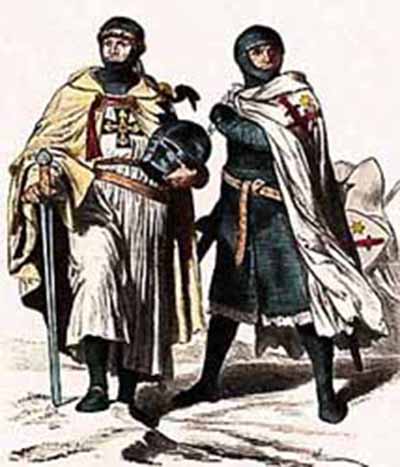
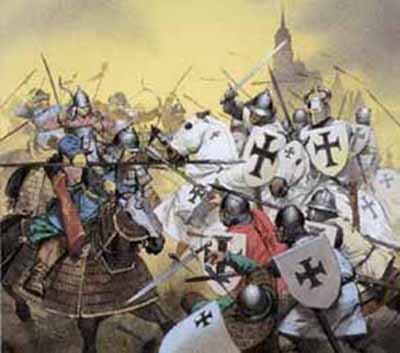


The Order of Brothers of the German House of Saint Mary in Jerusalem, commonly the Teutonic Order (Today: German Order - Deutscher Orden, also Deutschherren- or Deutschritterorden), was a German medieval military order, and in modern times a purely religious Catholic order. It was formed to aid Christians on their pilgrimages to the Holy Land and to establish hospitals. Its members have commonly been known as the Teutonic Knights, since they also served as a crusading military order in the Middle Ages.
The military membership was always small, with volunteers and mercenaries augmenting the force as needed. After the Reformation, the Bailiwick of Utrecht of the Order became Protestant; this branch still consists of knights, but the modern Roman Catholic order consists of Roman Catholic priests, nuns, and associates.
Formed at the end of the 12th century in Acre, in the Levant, the medieval Order played an important role in Outremer, controlling the port tolls of Acre. After Christian forces were defeated in the Middle East, the Order moved to Transylvania in 1211 to help defend Hungary against the Kipchaks. The Knights were expelled in 1225, after allegedly attempting to place themselves under Papal instead of Hungarian sovereignty.
In 1230, following the Golden Bull of Rimini, Grand Master Hermann von Salza and Duke Konrad I of Masovia launched the Prussian Crusade, a joint invasion of Prussia intended to Christianize the Baltic Old Prussians. The Order then created the independent Monastic State of the Teutonic Knights in the conquered territory, and subsequently conquered Livonia. The Kings of Poland accused the Order of holding lands rightfully theirs.
The Order lost its main purpose in Europe with the Christianisation of Lithuania. The Order became involved in campaigns against its Christian neighbours, the Kingdom of Poland, the Grand Duchy of Lithuania, and the Novgorod Republic (after assimilating the Livonian Order). The Teutonic Knights had a strong economic base, hired mercenaries from throughout Europe to augment their feudal levies, and became a naval power in the Baltic Sea. In 1410, a Polish-Lithuanian army decisively defeated the Order and broke its military power at the Battle of Grunwald (Tannenberg).
In 1515, Holy Roman Emperor Maximilian I made a marriage alliance with Sigismund I of Poland-Lithuania. Thereafter the Empire did not support the Order against Poland. In 1525, Grand Master Albert of Brandenburg resigned and converted to Lutheranism, becoming Duke of Prussia as a vassal of Poland. Soon after, the Order lost Livonia and its holdings in the Protestant areas of Germany.
The Order kept its considerable holdings in Catholic areas of Germany until 1809, when Napoleon Bonaparte ordered its dissolution and the Order lost its last secular holdings. The Order continued to exist as a charitable and ceremonial body. It was outlawed by Adolf Hitler in 1938, but re-established in 1945. Today it operates primarily with charitable aims in Central Europe.
The Knights wore white surcoats with a black cross. A cross pattee was sometimes used as their coat of arms; this image was later used for military decoration and insignia by the Kingdom of Prussia and Germany as the Iron Cross and Pour le Merite. The motto of the Order was:"Helfen, Wehren, Heilen" ("Help, Defend, Heal").
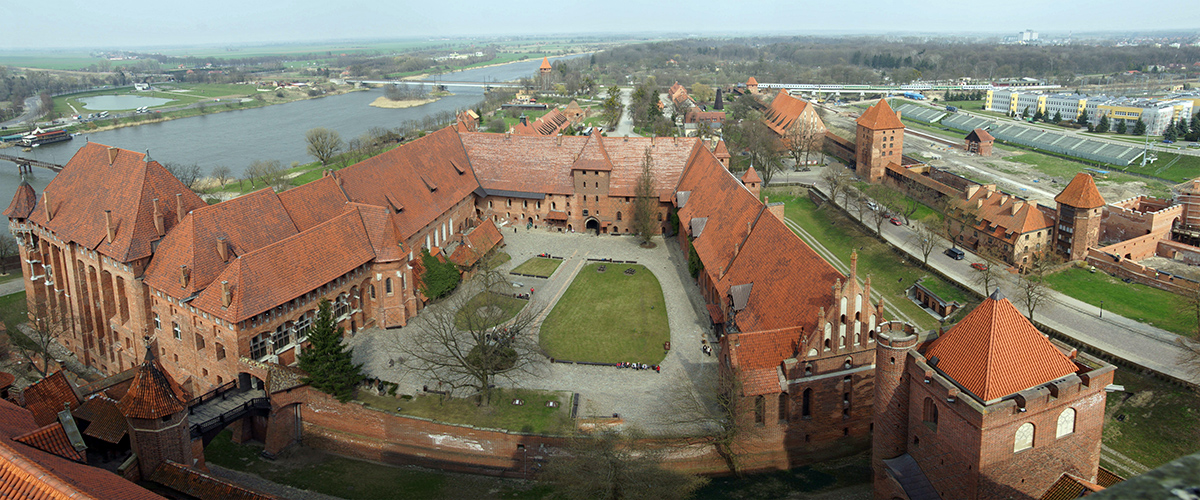
Castle of the Teutonic Order in Bad Mergentheim
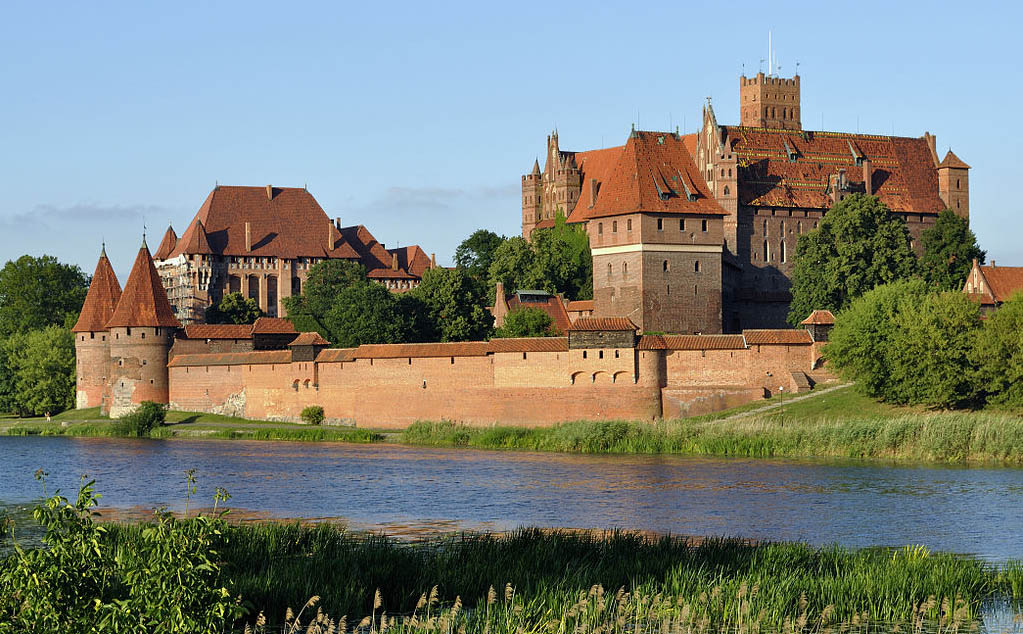
The Castle of the Teutonic Order in Malbork, is a classic example of a medieval fortress. On its completion in 1406, it became the world's largest brick castle. Nowadays, it's Poland's official national Historic Monument as designated in 1994. It also lists and is maintained by the National Heritage Board of Poland and World Heritage Site by UNESCO. After more than 600 years, it is still the largest castle in the world by surface area. Before the Teutonic Knights accomplished construction of the castle, it became the capital of their country. Nearby the castle, they created a town that the Order named Marienburg (Mary's Castle). Poland renamed it to Malbork Castle.
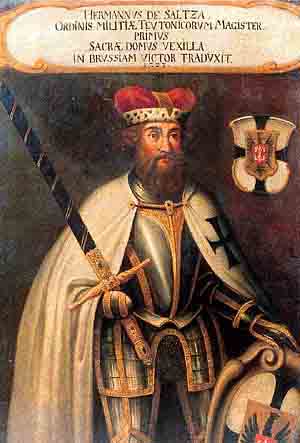
Murder in Malbork Castle: The Demise of Werner von Orseln, Grand Master of the Teutonic Order Ancient Origins - December 27, 2015
The capital castle of the Teutonic Order at Malbork, Poland, was famous for being unconquered. Apart from many battles around the castle in Malbork, these old medieval walls also saw the assassination of Grand Master Werner von Orseln, supposedly at the hands of a mad knight, known as Johan von Endorf. However, an examination of the details surrounding the murder raises questions about whether Endorf was really as mad or as guilty as he was purported to be.
In 1143 Pope Celestine II ordered the Knights Hospitaller to take over management of a German hospital in Jerusalem, which, according to the chronicler Jean d'Apres, accommodated the countless German pilgrims and crusaders who could neither speak the local language Although formally an institution of the Hospitallers, the pope commanded that the prior and the brothers of the domus Theutonicorum (house of the Germans) should always be Germans themselves, so a tradition of a German-led religious institution could develop during the 12th century in Palestine.
After the loss of Jerusalem in 1187, some merchants from Lubeck and Bremen took up the idea and founded a field hospital for the duration of the siege of Acre in 1190, which became the nucleus of the order; Celestine III recognized it in 1192 by granting the monks Augustinian Rule. Based on the model of the Knights Templar it was, however, transformed into a military order in 1198 and the head of the order became known as the Grand Master (magister hospitalis). It received papal orders for crusades to take and hold Jerusalem for Christianity and defend the Holy Land against the Muslim Saracens. During the rule of Grand Master Hermann von Salza (1209-1239) the Order changed from being a hospice brotherhood for pilgrims to primarily a military order.
Originally based in Acre, the Knights purchased Montfort (Starkenberg), northeast of Acre, in 1220. This castle, which defended the route between Jerusalem and the Mediterranean Sea, was made the seat of the Grand Masters in 1229, although they returned to Acre after losing Montfort to Muslim control in 1271. The Order also had a castle at Amouda in Armenia Minor. The Order received donations of land in the Holy Roman Empire (especially in present-day Germany and Italy), Frankish Greece, and Palestine.
Emperor Frederick II elevated his close friend Hermann von Salza to the status of Reichsfurst, or "Prince of the Empire", enabling the Grand Master to negotiate with other senior princes as an equal. During Frederick's coronation as King of Jerusalem in 1225, Teutonic Knights served as his escort in the Church of the Holy Sepulchre; von Salza read the emperor's proclamation in both French and German. However, the Teutonic Knights were never as influential in Outremer as the older Templars and Hospitallers.
In 1211, Andrew II of Hungary accepted their services and granted them the district of Burzenland in Transylvania. Andrew had been involved in negotiations for the marriage of his daughter with the son of Hermann, Landgrave of Thuringia, whose vassals included the family of Hermann von Salza. Led by a brother called Theoderich, the Order defended Hungary against the neighboring Cumans and settled new German colonists among those who were known as the Transylvanian Saxons, living there before.
In 1224 the Knights petitioned Pope Honorius III to be placed directly under the authority of the Papal See, rather than that of the King of Hungary. Angered and alarmed at their growing power, Andrew responded by expelling them in 1225, although he allowed the new colonists to remain.
During the first twenty years of its existence, the institutional structure of the Order developed and stabilized. The Teutonic Order followed the lead of the Templars and Hospitallers by creating a system of provinces. Unlike monastic orders composed of independent abbeys, the Teutonic Knights had a hierarchical chain of command with commanderies (house, Kommende) at the lowest level. Provinces or bailiwicks (Ballei, Komturei) were parts of "countries" that composed the Order as a whole. Its first independent rule was adopted in 1264.
The officials governing the Teutonic Order at the various levels were commander (Komtur, preceptor) at the local level, province commander (Landkomtur), national commander (Landmeister), and grand master (Hochmeister, magister). The highest leadership positions (including grand master, grand commander [Grosskomtur], marshal [Ordensmarschall], draper or quartermaster [Trapier], hospitaller [Spittler], and treasurer [Tressler]) were elected by the general chapter.
Membership of this mostly German-speaking order was composed of various, distinct classes: knights, priests, and other brothers (lay brothers, sisters, and "familiars"). There was a large number of people who supported the professed members of the Order, ranging from auxiliary knights to slaves. The highest ranking were secular knights, serving for free. Turcopoles (Greek for "son of Turk") were originally probably lightly-armed, half-breed cavalry whose name applied to Turkish mercenaries employed in the Byzantine army, later the term was adopted by the military orders. There were attendants called squires (knechte), and sergeants-at-arms. Footsoldiers were usually coerced from the local peasantry. Sister-aids (halpswesteren) were employed as domestics as were halpbrdyeren; they took religious vows. Married and single lay domestics also were employed by the Order. Artisans and laborers (e.g., gardeners, carpenters, masons) worked for charity or wages. Many serfs and slaves were owned by the Order.
From the outset, the possessions and wealth of the Teutonic Order grew astoundingly fast and its numbers skyrocketed, especially under Grand Master Hermann von Salza (c. 1210-1239). Von Salza was successful in gaining many favors for the Order because he was a confidante to both the German emperor Frederick II (1211-1250) and the popes. His immediate successors also did well. Between 1215 and 1300, one or more commanderies were founded each year, usually through gifts.
The Teutonic Order was invited into Greece (1209), Hungary (1211), and Prussia (1226) by secular rulers to perform military duties on their behalf. In the Peloponnesus the Frankish Prince of Achaia provided fiefs near Kalamata for the Teutonic Knights in return for military service; there are traces of the Order's continuous service there until 1500. The Hungarian King Andrew II (1205-1235) expelled the Order in 1225 when it became strong and may have threatened his rule. The conquest of Prussia began in 1230 (after the Order's Grand Master was named prince of the Holy Roman Empire) and lasted until 1283.
In addition to the Holy Land and these other "theaters of war," the order's members could be found elsewhere in the Mediterranean and western Europe: Armenia, Cyprus, Sicily, Apulia, Lombardy, Spain, France, Alsace, Austria, Bohemia, the Lowlands, Germany, and Livonia. Only in the frontier areas (the Holy Land, Armenia, Greece, Hungary, Prussia, Spain, and Livonia) was military service required of members.
By 1221 the German Order was given the same privileges as the Templars and Hospitallers by Pope Honorius III (1216-1227). Both senior orders fought the autonomy of the Teutonic Order until about 1240. The German Order may not have quite equaled in wealth and possessions the other two military orders which were more than 80 years older, but it became the only other order to rival them in international influence and activity.
In 1226, Konrad I, Duke of Masovia in north-eastern Poland, appealed to the Knights to defend his borders and subdue the pagan Baltic Prussians, allowing the Teutonic Knights use of Chelmno Land (Culmerland) as a base for their campaign. This being a time of widespread crusading fervor throughout Western Europe, Hermann von Salza considered Prussia a good training ground for his knights for the wars against the Muslims in Outremer. With the Golden Bull of Rimini, Emperor Frederick II bestowed on the Order a special imperial privilege for the conquest and possession of Prussia, including Chelmno Land, with nominal papal sovereignty. In 1235 the Teutonic Knights assimilated the smaller Order of Dobrzyn, which had been established earlier by Christian, the first Bishop of Prussia.
The conquest of Prussia was accomplished with much bloodshed over more than 50 years, during which native Prussians who remained unbaptized were subjugated, killed, or exiled. Fighting between the Knights and the Prussians was ferocious; chronicles of the Order state the Prussians would "roast captured brethren alive in their armor, like chestnuts, before the shrine of a local god".
The native nobility who submitted to the crusaders had many of their privileges affirmed in the Treaty of Christburg. After the Prussian uprisings of 1260-83, however, much of the Prussian nobility emigrated or were resettled, and many free Prussians lost their rights. The Prussian nobles who remained were more closely allied with the German landowners and gradually assimilated. Peasants in frontier regions, such as Samland, had more privileges than those in more populated lands, such as Pomesania. The crusading knights often accepted baptism as a form of submission by the natives. Christianity along western lines slowly spread through Prussian culture. Bishops were reluctant to have Prussian religious practices integrated into the new faith, while the ruling knights found it easier to govern the natives when they were semi-pagan and lawless. After 50 years of warfare and brutal conquest the end result meant that most of the Prussian natives were either killed or deported.
The Order ruled Prussia under charters issued by the Pope and the Holy Roman Emperor as a sovereign monastic state, comparable to the arrangement of the Knights Hospitallers in Rhodes and later in Malta.
To make up for losses from the plague and to replace the partially exterminated native population, the Order encouraged the immigration of colonists from the Holy Roman Empire of the German Nation (mostly Germans, Flemish, and Dutch) and from Masovia (Poles), the later Masurians. The colonists included nobles, burghers, and peasants, and the surviving Old Prussians were gradually assimilated through Germanization.
The settlers founded numerous towns and cities on former Prussian settlements. The Order itself built a number of castles (Ordensburgen) from which it could defeat uprisings of Old Prussians, as well as continue its attacks on the Grand Duchy of Lithuania and the Kingdom of Poland, with which the Order was often at war during the 14th and 15th centuries. Major towns founded by the Order included Konigsberg, founded in 1255 in honor of King Otakar II of Bohemia on the site of a destroyed Prussian settlement, Allenstein (Olsztyn), Elbing (Elblag), and Memel (Klaipeda).
In 1236 the Knights of Saint Thomas, an English order, adopted the rules of the Teutonic Order. The Livonian Brothers of the Sword were absorbed by the Teutonic Knights in 1237; the Livonian branch subsequently became known as the Livonian Order. The Teutonic Order's nominal territorial rule extended over Prussia, Livonia, Semigalia, and Estonia.
Its next aim was to convert Orthodox Russia to Catholicism, but after the knights suffered a disastrous defeat in the Battle on Lake Peipus (1242) at the hands of Prince Alexander Nevsky of Novgorod, this plan had to be abandoned. A contingent of Teutonic Knights of indeterminate number is traditionally believed to have participated at the Battle of Legnica in 1241 against the Mongols. However, recent analysis of the 15th century Annals of Jan Dlugosz by Labuda suggests that the German crusaders may have been added to the text (listing the Allied Army) after the chronicler Dlugosz had completed the work. Legnica is the furthest west the Mongol expansion would reach in Europe.
In 1242, the Teutonic Knights invaded the Republic of Novgorod (located in modern-day Russia) but were defeated at Lake Peipus and pushed back by the forces of prince and commanding general at Novgorod Alexander Nevski. This battle is known in Russia as the Battle of the Ice, although correct translation from Russian would be ice slaughter.
The Teutonic Knights began to direct their campaigns against pagan Lithuania, especially after the fall of the Kingdom of Jerusalem at Acre in 1291. The knights moved their headquarters to Venice, from which they planned the recovery of Outremer. Because "Lithuania Propria" remained non-Christian until the end of the 14th century, much later than the rest of eastern Europe, many knights from western European countries, such as England and France, journeyed to Prussia to participate in the seasonal campaigns (reyse) against the Grand Duchy of Lithuania. Some of them campaigned against pagans to obtain remission for their sins, while others fought to gain military experience.
Warfare between the Order and the Lithuanians was especially brutal. Non-Christians were seen as lacking rights possessed by Christians. Because enslavement of non-Christians was seen as acceptable at the time and the subdued native Prussians demanded land or payment, the Knights often used captured pagan Lithuanians for forced labor.
It was a total war in every sense of the word. Lasting for more than 200 years, having its front line along the river Nemunas (with as many as 20 forts and castles only between Seredzius and Jurbarkas, strip of about 45 km) and 10-50 km buffer zone, stretching on the both banks, absolutely desolated wasteland. This struggle was so deeply etched into Lithuanian culture and mentality that even now it is probably the biggest source of national pride and self-identity.
A dispute over the succession to the Duchy of Pomerelia embroiled the Order in further conflict in the beginning of the 14th century. The Margraves of Brandenburg had claims to the duchy which they acted upon after the death of King Wenceslaus of Poland in 1306. Duke Wladyslaw I the Elbow-high of Poland claimed the duchy as well basing on inheritance from Przemyslaw II, but was opposed by some Pomeranians nobles. They requested help from Brandenburg, which subsequently occupied all of Pomerelia except for the citadel of Danzig (Gdansk) in 1308. Because Wladyslaw was unable to come to the defense of Danzig, the Teutonic Knights, then led by Hochmeister Siegfried von Feuchtwangen, were hired to expel the Brandenburgers.
The Order, under Prussian Landmeister Heinrich von Plotzke, evicted the Brandenburgers from Danzig in September 1308 but then refused to yield the town to the Poles and massacred the town's inhabitants. In the Treaty of Soldin, the Teutonic Order purchased Brandenburg's supposed claim to the castles of Danzig, Schwetz (Swiecie), and Dirschau (Tczew) and their hinterlands from the margraves for 10,000 marks on September 13, 1309
Control of Pomerelia allowed the Order to connect their monastic state with the borders of the Holy Roman Empire. Crusading reinforcements and supplies could travel from the Imperial territory of Hither Pomerania through Pomerelia to Prussia, while Poland's access to the Baltic Sea was blocked. While Poland had mostly been an ally of the knights against the pagan Prussians and Lithuanians, the capture of Pomerelia turned the kingdom into a determined enemy of the Order.
The capture of Danzig marked a new phase in the history of the Teutonic Knights. The persecution and abolition of the powerful Knights Templar which began in 1307 worried the Teutonic Knights, but control of Pomerelia allowed them to move their headquarters in 1309 from Venice to Marienburg (Malbork) on the Nogat River, outside of the reach of secular powers. The position of Prussian Landmeister was merged with that of the Grand Master. The Pope began investigating misconduct by the knights, but the Order was defended by able jurists. Along with the campaigns against the Lithuanians, the knights faced a vengeful Poland and legal threats from the Papacy.
The Treaty of Kalisz of 1343 ended open war between the Teutonic Knights and Poland. The Knights relinquished Kuyavia and Dobrzyn Land to Poland, but retained Culmerland and Pomerelia with Danzig.
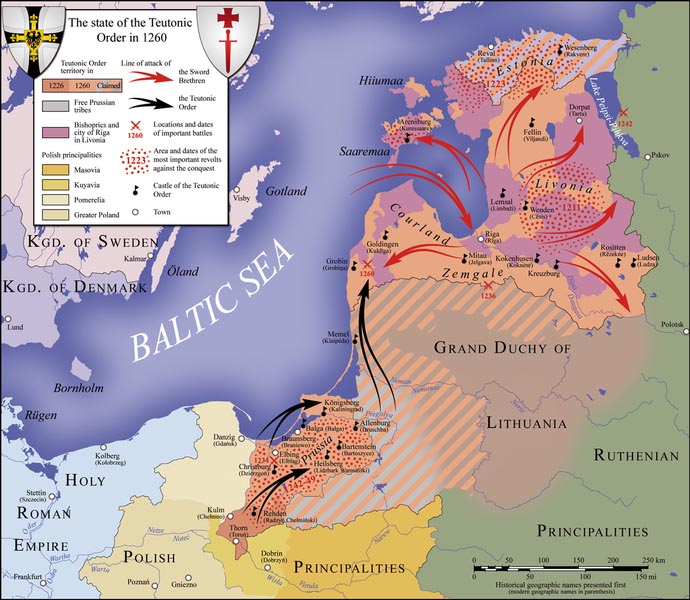
Map of the Teutonic state in 1260
In 1337 Emperor Louis IV allegedly granted the Order the imperial privilege to conquer all Lithuania and Russia. During the reign of Grand Master Winrich von Kniprode (1351-1382), the Order reached the peak of its international prestige and hosted numerous European crusaders and nobility.
King Albert of Sweden ceded Gotland to the Order as a pledge (similar to a fiefdom), with the understanding that they would eliminate the pirating Victual Brothers from this strategic island base in the Baltic Sea. An invasion force under Grand Master Konrad von Jungingen conquered the island in 1398 and drove the Victual Brothers out of Gotland and the Baltic Sea.
In 1386 Grand Duke Jogaila of Lithuania was baptized into Christianity and married Queen Jadwiga of Poland, taking the name Wladyslaw II Jagiello and becoming King of Poland. This created a personal union between the two countries and a potentially formidable opponent for the Teutonic Knights. The Order initially managed to play Jagiello and his cousin Vytautas against each other, but this strategy failed when Vytautas began to suspect that the Order was planning to annex parts of his territory.
The baptism of Jagiello began the official conversion of Lithuania to Christianity. Although the crusading rationale for the Order's state ended when Prussia and Lithuania had become officially Christian, the Order's feuds and wars with Lithuania and Poland continued. The Lizard Union was created in 1397 by Prussian nobles in Culmerland to oppose the Order's policy.
In 1407 the Teutonic Order reached its greatest territorial extent and included the lands of Prussia, Pomerelia, Samogitia, Courland, Livonia, Estonia, Gotland, Dago, Osel, and the Neumark, pawned by Brandenburg in 1402.
In 1410 at the Battle of Grunwald - known in Lithuanian as the Battle of Zalgiris - a combined Polish-Lithuanian army, led by Vytautas and Jogaila, decisively defeated the Order in the Polish-Lithuanian-Teutonic War. Grand Master Ulrich von Jungingen and most of the Order's higher dignitaries fell on the battlefield (50 out of 60). The Polish-Lithuanian army then besieged the capital of the Order, Marienburg, but was unable to take it owing to the resistance of Heinrich von Plauen. When the First Peace of Thorn was signed in 1411, the Order managed to retain essentially all of its territories, although the Knights' reputation as invincible warriors was irreparably damaged.
While Poland and Lithuania were growing in power, that of the Teutonic Knights dwindled through infighting. They were forced to impose high taxes to pay a substantial indemnity but did not give the cities sufficient requested representation in the administration of their state. The authoritarian and reforming Grand Master Heinrich von Plauen was forced from power and replaced by Michael Kuchmeister von Sternberg, but the new Grand Master was unable to revive the Order's fortunes.
After the Gollub War the Knights lost some small border regions and renounced all claims to Samogitia in the 1422 Treaty of Melno. Austrian and Bavarian knights feuded with those from the Rhineland, who likewise bickered with Low German-speaking Saxons, from whose ranks the Grand Master was usually chosen. The western Prussian lands of the Vistula River Valley and the Brandenburg Neumark were ravaged by the Hussites during the Hussite Wars. Some Teutonic Knights were sent to battle the invaders, but were defeated by the Bohemian infantry. The Knights also sustained a defeat in the Polish-Teutonic War (1431-1435).
In 1454 the Prussian Confederation, consisting of the gentry and burghers of western Prussia, rose up against the Order, beginning the Thirteen Years' War. Much of Prussia was devastated in the war, during the course of which the Order returned Neumark to Brandenburg in 1455. In the Second Peace of Thorn (1466), the defeated Order recognized the Polish crown's rights over western Prussia (subsequently Royal Prussia) while retaining eastern Prussia under nominal Polish overlordship. Because Marienburg Castle was handed over to mercenaries in lieu of their pay, the Order moved its base to Königsberg in Sambia.
The Order was completely ousted from Prussia when Grand Master Albert of Brandenburg, after the Polish–Teutonic War (1519–1521), converted to Lutheranism in 1525, secularized the Order's remaining Prussian territories, and assumed from King Sigismund I the Old of Poland, his uncle, the hereditary rights to the Duchy of Prussia as a vassal of the Polish Crown in the Prussian Homage. The Protestant Duchy of Prussia was thus a fief of Catholic Poland.
Although it had lost control of all of its Prussian lands, the Teutonic Order retained its territories within the Holy Roman Empire and Livonia, although the Livonian branch retained considerable autonomy. Many of the Imperial possessions were ruined in the German Peasants' War from 1524 to 1525 and subsequently confiscated by Protestant territorial princes. The Livonian territory was then partitioned by neighboring powers during the Livonian War; in 1561 the Livonian Master Gotthard Kettler secularized the southern Livonian possessions of the Order to create the Duchy of Courland, also a vassal of Poland.
After the loss of Prussia in 1525, the Teutonic Knights concentrated on their possessions in the Holy Roman Empire. Since they held no contiguous territory, they developed a three-tiered administrative system: holdings were combined into commanderies which were administered by a commander (Komtur). Several commanderies were combined to form a bailiwick headed by a Landkomtur. All of the Teutonic Knights' possessions were subordinate to the Grand Master whose seat was in Bad Mergentheim.
Martin Luther's (1483-1546) Reformation affected the Teutonic Order significantly. In 1525, Grand Master Albrecht von Brandenburg converted to the Lutheran faith. He then was enfoeffed by the Polish king as Duke of Prussia. As a medieval, crusading entity, the German Order essentially ended at this time.
In 1526, the Teutonic Order master of the German lands became the "Administrator of the Grandmastery in Prussia and Master in German and Romance Countries." Mergentheim became the main seat of the Order.
There was a great deal of confusion in Germany in the aftermath of the Reformation, its resulting wars, and the political changes. The bailiwicks of Saxony, Messe, and The ringia became Protestant until Napoleonic times. The office of Landkomtur alternated among Lutheran, Reformed, and Catholic leaders in the sixteenth and seventeenth centuries. The bailiwick of Utrecht was Calvinist until modern times. A new rule was adopted in 1606 in an attempt to accommodate the changes in the Order.
In European affairs, from time to time, the Order still participated militarily. Some 1000 troops were raised to help the Austrians against the Turks. After 1696, there was a regiment of the "Grand and German Master." But the numbers and wealth of the Order dwindled. Little other military activity is recorded.
As the anticlerical French government expanded its political control in the 1790's, the Order lost its commanderies in Belgium and those west of the Rhine (1797). Many east of the Rhine were lost in 1805. In 1809, Napoleon dissolved the Order in all countries under his dominion, leaving only the properties in the Austrian Empire.
Even in Austria, the Order had to exist secretly for a number of years until 1839 when Austrian Emperor Ferdinand I reconstituted the Order as the Order of the Teutonic Knights (Deutscher Ritterorden). The mission fulfilled by the Order was mainly the caring for wounded soldiers.
In 1866, the "Honorable Knights of the Teutonic Order" was founded. Knights were required to provide annual contributions for hospitals. The Marianer des Deutschen Ordens, for women, was created in 1871.
Emperor Wilhelm II of Germany posed for a photo in 1902 in the garb of a monk from the Teutonic Order, climbing the stairs in the reconstructed Marienburg Castle as a symbol of Imperial German policy.
In 1914, some 1,500 sponsors from the Austrian nobility supported the caregiving efforts of the Order. During World War I, the Order took care of about 3,000 wounded soldiers in their facilities.
In 1923, masters of the Order were allowed to come from among the clerics rather than the "knighthood" for the first time.
German nationalism often invoked the imagery of the Teutonic Knights, especially in the context of territorial conquest from eastern neighbors of Germany and conflict with nations of Slavic origins, whom German nationalists considered less developed and of inferior culture. The German historian Heinrich von Treitschke used imagery of the Teutonic Knights to promote pro-German and anti-Polish rhetoric. Many middle-class German nationalists adopted this imagery and its symbols. During the Weimar Republic, associations and organizations of this nature contributed to laying the groundwork for the formation of Nazi Germany.
Before and during World War II, Nazi propaganda and ideology made frequent use of the Teutonic Knights' imagery, as the Nazis sought to depict the Knights' actions as a forerunner of the Nazi conquests for Lebensraum. Heinrich Himmler tried to idealize the SS as a 20th-century re-incarnation of the medieval Order. Yet, despite these references to the Teutonic Order's history in Nazi propaganda, the Order itself was abolished in 1938 and its members were persecuted by the German authorities. This occurred mostly due to Hitler's and Himmler's belief, that throughout history Roman Catholic military-religious orders had been tools of the Holy See and as such constituted a threat to the Nazi regime.
The converse was true for Polish nationalism, which used the Teutonic Knights as symbolic shorthand for Germans in general, conflating the two into an easily recognizable image of the hostile. Similar associations were used by Soviet propagandists, such as the Teutonic knight villains in the 1938 Sergei Eisenstein film Aleksandr Nevskii. Lithuanian nationalists, particularly in the 19th century, used the history of their wars with the Teutonic Order to idealise the heroism of the medieval Lithuanians, a very strong argument in support of preserving the Lithuanian language, history and culture
Under National Socialist rule, the Order was dissolved in Austria in 1938 and Czechoslovakia in 1939. The leaders of the Third Reich abused the history of the Teutonic Order. After World War II, the Order began anew in Germany. Its possessions in Austria were returned. In Italy, the Order had changed little. A great deal of support for the care-taking and missionary Order has been found in Germany, Austria, Italy, Belgium, and even in North and Central America. The Order's headquarters, treasury, and archives are now located in Vienna, Austria. Teutonic Knights
1241 The Battle of Legnica
1242 The Battle of the Ice, 20 Knights killed, 6 captured
1242–1249 First Prussian Uprising
1249 Treaty of Christburg with the pagan Prussians signed on February 9
1249 Battle of Krücken, 54 Knights slaughtered
1260–1274 Great Prussian Uprising
1260 Battle of Durbe, 150 Knights killed
1262 Siege of Konigsberg
1263 Battle of Lobau, 40 Knights killed
1264 Siege of Bartenstein
1271 Battle of Pagastin, 12 Knights killed
1279 Battle of Aizkraukle, 71 Knights killed
1308-1309 Teutonic takeover of Danzig and Treaty of Soldin
1326-1332 Polish-Teutonic War (1326–1332) for Kuyavia, with involvement of Lithuania and Hungary
1331 Battle of Plowce, 73 Knights killed, 56 captured
1343 Treaty of Kalisz, exchange of Kuyavia for Kulm and other territories
1409-1411 Polish-Lithuanian-Teutonic War, the teutonic knights are defeated by Polish king Wladyslaw II Jagiello and Lithuanian Grand duke Vytautas the Great at the Battle of Tannenberg (1410)
1414 Hunger War, 86 Knights killed
1422 Gollub War ending with the Treaty of Melno
1431–1435 Polish-Teutonic War
1454–1466 Thirteen Years' War
1466 Second Peace of Thorn (1466)
1467–1479 War of the Priests
1519–1521 Polish-Teutonic War (1519–1521)
1525 Order loses Prussia due to the Prussian Homage